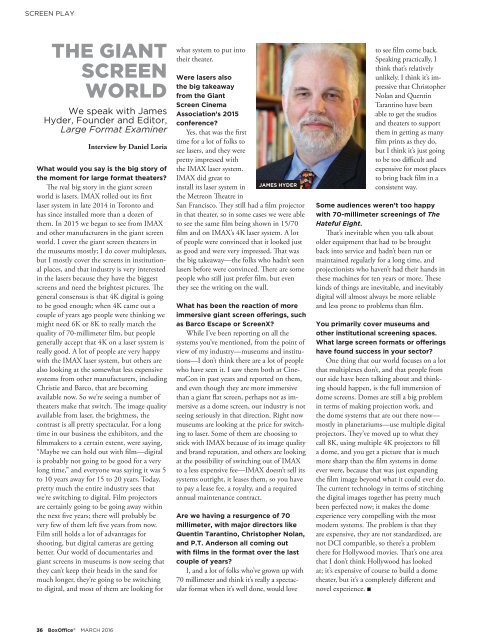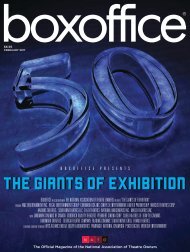Boxoffice - March 2016
The Official Magazine of the National Association of Theatre Owners
The Official Magazine of the National Association of Theatre Owners
You also want an ePaper? Increase the reach of your titles
YUMPU automatically turns print PDFs into web optimized ePapers that Google loves.
SCREEN PLAY<br />
THE GIANT<br />
SCREEN<br />
WORLD<br />
We speak with James<br />
Hyder, Founder and Editor,<br />
Large Format Examiner<br />
Interview by Daniel Loria<br />
What would you say is the big story of<br />
the moment for large format theaters?<br />
The real big story in the giant screen<br />
world is lasers. IMAX rolled out its first<br />
laser system in late 2014 in Toronto and<br />
has since installed more than a dozen of<br />
them. In 2015 we began to see from IMAX<br />
and other manufacturers in the giant screen<br />
world. I cover the giant screen theaters in<br />
the museums mostly; I do cover multiplexes,<br />
but I mostly cover the screens in institutional<br />
places, and that industry is very interested<br />
in the lasers because they have the biggest<br />
screens and need the brightest pictures. The<br />
general consensus is that 4K digital is going<br />
to be good enough; when 4K came out a<br />
couple of years ago people were thinking we<br />
might need 6K or 8K to really match the<br />
quality of 70-millimeter film, but people<br />
generally accept that 4K on a laser system is<br />
really good. A lot of people are very happy<br />
with the IMAX laser system, but others are<br />
also looking at the somewhat less expensive<br />
systems from other manufacturers, including<br />
Christie and Barco, that are becoming<br />
available now. So we’re seeing a number of<br />
theaters make that switch. The image quality<br />
available from laser, the brightness, the<br />
contrast is all pretty spectacular. For a long<br />
time in our business the exhibitors, and the<br />
filmmakers to a certain extent, were saying,<br />
“Maybe we can hold out with film—digital<br />
is probably not going to be good for a very<br />
long time,” and everyone was saying it was 5<br />
to 10 years away for 15 to 20 years. Today,<br />
pretty much the entire industry sees that<br />
we’re switching to digital. Film projectors<br />
are certainly going to be going away within<br />
the next five years; there will probably be<br />
very few of them left five years from now.<br />
Film still holds a lot of advantages for<br />
shooting, but digital cameras are getting<br />
better. Our world of documentaries and<br />
giant screens in museums is now seeing that<br />
they can’t keep their heads in the sand for<br />
much longer, they’re going to be switching<br />
to digital, and most of them are looking for<br />
what system to put into<br />
their theater.<br />
Were lasers also<br />
the big takeaway<br />
from the Giant<br />
Screen Cinema<br />
Association’s 2015<br />
conference?<br />
Yes, that was the first<br />
time for a lot of folks to<br />
see lasers, and they were<br />
pretty impressed with<br />
the IMAX laser system.<br />
IMAX did great to<br />
install its laser system in<br />
JAMES HYDER<br />
the Metreon Theatre in<br />
San Francisco. They still had a film projector<br />
in that theater, so in some cases we were able<br />
to see the same film being shown in 15/70<br />
film and on IMAX’s 4K laser system. A lot<br />
of people were convinced that it looked just<br />
as good and were very impressed. That was<br />
the big takeaway—the folks who hadn’t seen<br />
lasers before were convinced. There are some<br />
people who still just prefer film, but even<br />
they see the writing on the wall.<br />
What has been the reaction of more<br />
immersive giant screen offerings, such<br />
as Barco Escape or ScreenX?<br />
While I’ve been reporting on all the<br />
systems you’ve mentioned, from the point of<br />
view of my industry—museums and institutions—I<br />
don’t think there are a lot of people<br />
who have seen it. I saw them both at CinemaCon<br />
in past years and reported on them,<br />
and even though they are more immersive<br />
than a giant flat screen, perhaps not as immersive<br />
as a dome screen, our industry is not<br />
seeing seriously in that direction. Right now<br />
museums are looking at the price for switching<br />
to laser. Some of them are choosing to<br />
stick with IMAX because of its image quality<br />
and brand reputation, and others are looking<br />
at the possibility of switching out of IMAX<br />
to a less expensive fee—IMAX doesn’t sell its<br />
systems outright, it leases them, so you have<br />
to pay a lease fee, a royalty, and a required<br />
annual maintenance contract.<br />
Are we having a resurgence of 70<br />
millimeter, with major directors like<br />
Quentin Tarantino, Christopher Nolan,<br />
and P.T. Anderson all coming out<br />
with films in the format over the last<br />
couple of years?<br />
I, and a lot of folks who’ve grown up with<br />
70 millimeter and think it’s really a spectacular<br />
format when it’s well done, would love<br />
to see film come back.<br />
Speaking practically, I<br />
think that’s relatively<br />
unlikely. I think it’s impressive<br />
that Christopher<br />
Nolan and Quentin<br />
Tarantino have been<br />
able to get the studios<br />
and theaters to support<br />
them in getting as many<br />
film prints as they do,<br />
but I think it’s just going<br />
to be too difficult and<br />
expensive for most places<br />
to bring back film in a<br />
consistent way.<br />
Some audiences weren’t too happy<br />
with 70-millimeter screenings of The<br />
Hateful Eight.<br />
That’s inevitable when you talk about<br />
older equipment that had to be brought<br />
back into service and hadn’t been run or<br />
maintained regularly for a long time, and<br />
projectionists who haven’t had their hands in<br />
these machines for ten years or more. These<br />
kinds of things are inevitable, and inevitably<br />
digital will almost always be more reliable<br />
and less prone to problems than film.<br />
You primarily cover museums and<br />
other institutional screening spaces.<br />
What large screen formats or offerings<br />
have found success in your sector?<br />
One thing that our world focuses on a lot<br />
that multiplexes don’t, and that people from<br />
our side have been talking about and thinking<br />
should happen, is the full immersion of<br />
dome screens. Domes are still a big problem<br />
in terms of making projection work, and<br />
the dome systems that are out there now—<br />
mostly in planetariums—use multiple digital<br />
projectors. They’ve moved up to what they<br />
call 8K, using multiple 4K projectors to fill<br />
a dome, and you get a picture that is much<br />
more sharp than the film systems in dome<br />
ever were, because that was just expanding<br />
the film image beyond what it could ever do.<br />
The current technology in terms of stitching<br />
the digital images together has pretty much<br />
been perfected now; it makes the dome<br />
experience very compelling with the most<br />
modern systems. The problem is that they<br />
are expensive, they are not standardized, are<br />
not DCI compatible, so there’s a problem<br />
there for Hollywood movies. That’s one area<br />
that I don’t think Hollywood has looked<br />
at; it’s expensive of course to build a dome<br />
theater, but it’s a completely different and<br />
novel experience. n<br />
36 BoxOffice ® MARCH <strong>2016</strong>

















